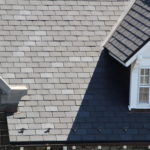
Warm Climates
If you live in a region with warm temperatures throughout the year, consider a roofing material that will release, rather than store or absorb, the heat from sun. You have the option of installing a cool roof, which reflects more sunlight and absorbs less heat than your standard roof. These types of roofs feature a reflective paint, as well as a sheet covering or reflective tiles and shingles. Dark roofs can reach a whopping 150 degrees Fahrenheit in the summer sun, while a cool roof can stay more than 50 degrees cooler.
Cool roofs also come with plenty of other benefits. They can lead to lower energy bills because occupants won’t need to use as much air conditioning during the summer, they can improve indoor comfort for non-air conditioned spaces, and they can extend the roof’s service life. The United States Department of Energy also points out that cool roofs can also do wonders for the surrounding environment, reducing local air temperatures, lowering peak electricity demand, and reducing power plant emissions, due to a lower demand for cooling energy use.
Cold Climates
People living in cold climates have an entirely different set of weather problems: freezing rain, snow, sleet, and cold. Roofs in such locales must be sized properly, well-sealed, and energy efficient, with the durability to handle the extremes of each season. Asphalt shingles are a popular choice in regions that see cooler temps, with shingles providing a high durability against the weather, with more insulation properties and a life expectancy of about 30 years, according to home improvement guru Bob Vila. However, these shingles can warp and develop algae in moist, damp climates. Steel roofs are recommended for areas that see high winds on a regular basis. Metal roofs are good for wintry locales, as the snow just melts right off.
Green Solutions
You can have your cake and eat it too, thanks to the recent invention of a new “smart” roof that saves energy in both hot and cold climates. According to U.S. News and World Report, scientists have developed a roof coating made from waste cooking oil from fast food restaurants that has the ability to interpret thermometer readings and switch roles depending on the weather — either reflecting or transmitting solar heat. This bio-based intelligent roof coating repels summer sunlight and significantly reduces air-conditioning bills. When the colder air arrives, it transmits heat to help warm the interior of the structure.
The roofing method you choose will ultimately depend on your budget, as well as the environment in which you live. Consult with a professional roofing company to find the best option for you.
This article was written by Jared Miret, father and home handyman. He spent many hours researching roofing when he was shopping for his own roofing in New Orleans, and he is excited to make your roofing quest a little easier.







